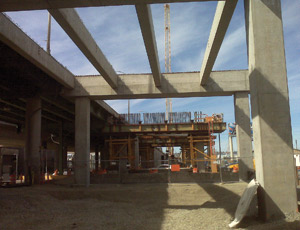While the replacement of Seattle’s aging Alaskan Way Viaduct plods toward a definite construction start date, long-needed improvements are well on the road to completion on another of the city’s critical elevated structures.

PCL Construction Services Inc., Seattle, has completed 257 drilled shafts for columns that will support the widening of the 3,000-ft-long Spokane Street Viaduct. One of Seattle’s five busiest roads, the viaduct carries up to 70,000 vehicles a day between Interstate 5 and the West Seattle Bridge and serves as a primary truck route for the Port of Seattle and the Harbor Island industrial area.
The $72-million project will nearly double the width of the 60-year-old, 45-ft-wide T-beam structure, providing new lanes for through traffic and transit and eliminating multiple safety hazards.
Beneath the viaduct, Spokane Street is being rebuilt with new concrete paving, curbs, sidewalks, and improved pedestrian and bicycle access. The project also includes a new 900-ft-long, two-lane entrance/exit ramp to First Street.
Although it has a far lower public profile outside Seattle than the Alaskan Way Viaduct’s along the downtown waterfront, the Spokane Street Viaduct owes the impetus for its own upgrades to its higher-profile counterpart.
Seattle Dept. of Transportation project manager Stuart Goldsmith explains that upgrade plans have awaited implementation since the mid-1990s. “Because of funding limitations, we’ve had to move forward in phases, focusing mainly on seismic retrofits to the existing structure, a temporary median to improve traffic safety and preliminary utility relocations,” he says. One step was the installation of steel jackets on the columns in 1999. The strengthened viaduct stood up to the Nisqually earthquake a year later.
The need to improve traffic capacity in downtown Seattle in advance of an Alaskan Way Viaduct replacement “pressured us to get this project going,” adds Goldsmith. The project received $15 million in stimulus funds.
Because the viaduct parallels a major utility route, says Virgil Schmidt, project manager with URS, SDOT’s construction management consultant, “we’ve relocated major phone and power lines, water mains and sewers as well as a few things we didn’t expect to find.” Among them were a large duct bank and wooden pilings from a trestle for the Interurban Connector, a former streetcar system.
Thanks to a coordinated “potholing” program in advance of major drilling, PCL kept equipment standby time to a minimum. “We were able to absorb any unexpected finds into our schedule,” says PCL project manager Kyle Richardson.
Far less surprising were the geotechnical conditions of the reclaimed mudflats of the Duwamish River. The 4-ft to 6-ft- dia shafts supporting the new structure’s 23-ft-tall cast-in-place columns were drilled 80 ft to 110 ft deep through fine sand, clay silt and a tidal-influenced water table just 10 ft deep.
Despite the area’s industrial history, the team encountered relatively little contamination. Most recovered water went to a wastewater treatment plant via storm sewers, while tainted soils were sorted by degree of contamination to help reduce the city’s landfilling expenses.
PCL recommended using locally sourced precast concrete for the girders, instead of the originally specified cast-in-place material. “That eliminated the need for span-to-span falsework and reduced the number of cross-street closures beneath the bridge,” Richardson says. PCL also salvaged several steel beams from three demolished access ramps to the existing viaduct, reusing them as construction supports for the new girders and cast-in-place column caps.
Completion of the subsurface work also means an end to most construction-related unknowns. Given the current pace of building 100 to 150 ft of concrete deck a week, Schmidt expects the new structure to be ready by the end of summer. Work will then shift to repairing the existing deck and adding a new concrete overlay.
“There will still be a lot of traffic maintenance issues to contend with, but we will maintain at least two lanes each way until the repair work is completed early next year,” he says.
That work could coincide with the Alaskan Way Viaduct’s replacement and several years of traffic disruptions in downtown Seattle. When that happens, Goldsmith says, “everything down here should be ready to handle it.”


Post a comment to this article
Report Abusive Comment